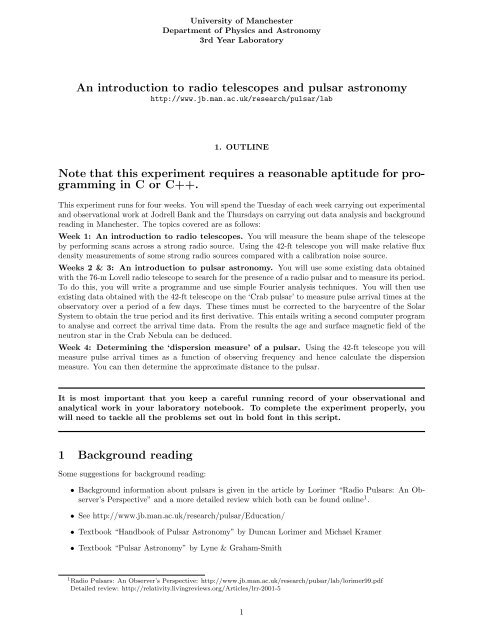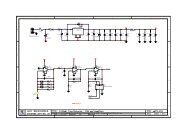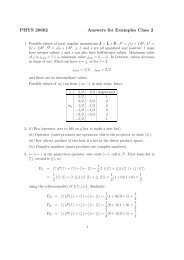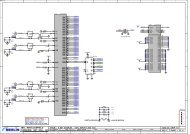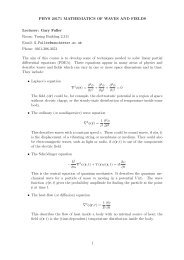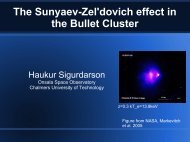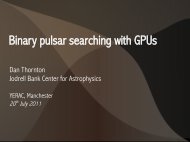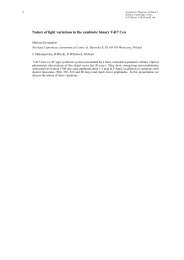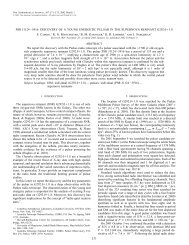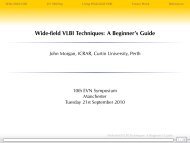Lab script - Jodrell Bank Centre for Astrophysics
Lab script - Jodrell Bank Centre for Astrophysics
Lab script - Jodrell Bank Centre for Astrophysics
Create successful ePaper yourself
Turn your PDF publications into a flip-book with our unique Google optimized e-Paper software.
University of Manchester<br />
Department of Physics and Astronomy<br />
3rd Year <strong>Lab</strong>oratory<br />
An introduction to radio telescopes and pulsar astronomy<br />
http://www.jb.man.ac.uk/research/pulsar/lab<br />
1. OUTLINE<br />
Note that this experiment requires a reasonable aptitude <strong>for</strong> programming<br />
in C or C++.<br />
This experiment runs <strong>for</strong> four weeks. You will spend the Tuesday of each week carrying out experimental<br />
and observational work at <strong>Jodrell</strong> <strong>Bank</strong> and the Thursdays on carrying out data analysis and background<br />
reading in Manchester. The topics covered are as follows:<br />
Week 1: An introduction to radio telescopes. You will measure the beam shape of the telescope<br />
by per<strong>for</strong>ming scans across a strong radio source. Using the 42-ft telescope you will make relative flux<br />
density measurements of some strong radio sources compared with a calibration noise source.<br />
Weeks 2 & 3: An introduction to pulsar astronomy. You will use some existing data obtained<br />
with the 76-m Lovell radio telescope to search <strong>for</strong> the presence of a radio pulsar and to measure its period.<br />
To do this, you will write a programme and use simple Fourier analysis techniques. You will then use<br />
existing data obtained with the 42-ft telescope on the ‘Crab pulsar’ to measure pulse arrival times at the<br />
observatory over a period of a few days. These times must be corrected to the barycentre of the Solar<br />
System to obtain the true period and its first derivative. This entails writing a second computer program<br />
to analyse and correct the arrival time data. From the results the age and surface magnetic field of the<br />
neutron star in the Crab Nebula can be deduced.<br />
Week 4: Determining the ‘dispersion measure’ of a pulsar. Using the 42-ft telescope you will<br />
measure pulse arrival times as a function of observing frequency and hence calculate the dispersion<br />
measure. You can then determine the approximate distance to the pulsar.<br />
It is most important that you keep a careful running record of your observational and<br />
analytical work in your laboratory notebook. To complete the experiment properly, you<br />
will need to tackle all the problems set out in bold font in this <strong>script</strong>.<br />
1 Background reading<br />
Some suggestions <strong>for</strong> background reading:<br />
• Background in<strong>for</strong>mation about pulsars is given in the article by Lorimer “Radio Pulsars: An Observer’s<br />
Perspective” and a more detailed review which both can be found online 1 .<br />
• See http://www.jb.man.ac.uk/research/pulsar/Education/<br />
• Textbook “Handbook of Pulsar Astronomy” by Duncan Lorimer and Michael Kramer<br />
• Textbook “Pulsar Astronomy” by Lyne & Graham-Smith<br />
1 Radio Pulsars: An Observer’s Perspective: http://www.jb.man.ac.uk/research/pulsar/lab/lorimer99.pdf<br />
Detailed review: http://relativity.livingreviews.org/Articles/lrr-2001-5<br />
1
2. AN INTRODUCTION TO RADIO TELESCOPES<br />
The primary reflecting surface of the telescope is a paraboloid of revolution which focusses the incoming<br />
radiation onto the ‘feed’ aerial (see Fig. 1). Its action is, there<strong>for</strong>e, to turn plane waves into spherical<br />
waves whose centre of curvature is at the primary focus. In order to maximise the efficiency of the<br />
telescope, power reflected from near the edges of the dish must be collected by the feed. However, in<br />
so doing unwanted power will also be picked up from the surroundings of the telescope; this is termed<br />
‘spillover’. The response of the feed as a function of direction is there<strong>for</strong>e tailored to maximise the<br />
ratio between the ‘gain’ of the telescope and the overall system noise temperature to which the spillover<br />
contributes (see below).<br />
θ<br />
Feed<br />
x<br />
Figure 1: Schematic diagram of a radio telescope<br />
2.1 The Beamshape and the Aperture Illumination<br />
To understand the response of the telescope as a function of direction it may be easier to think about<br />
waves being transmitted from the feed and reflected off the paraboloid and into space; the telescope’s<br />
characteristics are identical when transmitting or receiving (the reciprocity theorem). The waves from the<br />
feed excite changing currents in the reflecting surface and these in turn result in electromagnetic waves<br />
being radiated in the <strong>for</strong>ward direction; the overall far field pattern of the telescope (its voltage polar<br />
diagram) is a combination of these plane waves. This is Fraunhofer diffraction. The aperture distribution<br />
A(x) of surface currents is related to the voltage polar diagram, P(θ), by a Fourier Trans<strong>for</strong>m relationship.<br />
In one dimension:<br />
P(θ) =<br />
∫ D/2<br />
−D/2<br />
A(x)e i(2πx/λ)θ dx,<br />
where D is the diameter of the telescope, and λ is the observing wavelength (consult Hecht ‘Optics’,<br />
Chapter 10).<br />
An equivalent way to understand the ‘Fourier pair’ relationship between the aperture distribution and the<br />
far field pattern is to imagine the aperture distribution being made up from a set of sinusoidal standing<br />
waves (effectively a set of notional diffraction gratings across the aperture). By Fourier’s Theorem any<br />
such spatial distribution can be constructed out of a weighted set of sinusoids (spatial Fourier components).<br />
Each sinusoidal diffraction grating of spatial wavelength d gives rise to two plane waves (at ±θ<br />
where θ = λ/d) and the integrated effect of the plane waves from all the spatial Fourier components in<br />
the aperture produces the voltage polar diagram. Note the inverse relation between θ and d which is<br />
characteristic of a Fourier pair – the smaller is the spatial dimension involved, the larger is the angle<br />
over which waves are radiated. The larger is the telescope diameter, the longer are the spatial Fourier<br />
components which can can be ‘fitted in’ to the aperture and hence the more power which is radiated at<br />
small angles.<br />
N.B. Since the receiving system you are using responds to the total power rather than the complex<br />
voltage, the beam pattern you measure by scanning the telescope is called the power polar diagram of<br />
the telescope.<br />
2
The Fourier trans<strong>for</strong>m of a disk, the geometrical shape of the aperture of the telescope, is called a firstorder<br />
Bessel function and the square of this function, giving the power polar diagram, has a full-width<br />
at half maximum of 1.02λ/D radians, where D is the diameter of the telescope and λ is the wavelength.<br />
Scan the telescope across the strong source Cass A (see Appendix A, but ask the lab demonstrator<br />
<strong>for</strong> some additional instructions first) and measure the width of the power polar<br />
diagram (power polar representation of the telescope beam) between half-power points. Is<br />
this consistent with the known diameter of the telescope? Can you explain any differences?<br />
2.3 Calibration and Noise Temperature Measurements<br />
Noise Temperature: Essentially all the signals we deal with in radio astronomy are pure random noise.<br />
The parameter most often used to characterise these signals is the ‘noise temperature’ T (measured in<br />
K) which is directly proportional to mean noise power available from a resistor at temperature T. From<br />
the theorem of equipartition of energy there are kT/2 Joules of energy associated with each ‘degree of<br />
freedom’ of the system, i.e. in each Hz and in each of the two polarisation states. Thus the power per<br />
unit bandwidth is kT Watts Hz −1 and over a bandwidth B Hz the total power available is kTB Watts.<br />
Absolute calibration measurements in radio astronomy are there<strong>for</strong>e made using ‘hot and cold loads’<br />
which are resistors at well-defined temperatures (e.g. liquid He, liquid N and room temperature).<br />
After amplification, the random noise signals, which have a zero mean, are turned into a more useful <strong>for</strong>m<br />
by a detector. Usually in radio astronomy we use a device (most simply based on a diode operating on the<br />
bottom part of its characteristic curve) which responds to the square of the input voltage i.e. to the power<br />
of the random signal integrated over an appropriate period. In a basic receiver this period could be set<br />
by an RC ‘time constant’. Because the statistical nature of the input signal there is a random fluctuating<br />
component in the detected signal (see Fig. 2) whose magnitude is ∝ T/ √ Bτ where τ is the time over<br />
which the signal is averaged. (Note that this is akin to the fluctuations ∝ √ N in Poisson statistics).<br />
Thus the accuracy of the measurement of the mean power is increased by increasing the signal bandwidth<br />
and the averaging time.<br />
Fluctuations, rms= Tsys<br />
Bt<br />
Power Output<br />
Tsys<br />
Time<br />
Figure 2: The noisy signal after square-law detection<br />
The total noise power at the output of the receiver, often called the ‘system noise temperature’ T sys , has<br />
several contributions:<br />
i) T source , the desired contribution coming from the radio source.<br />
ii) T sky , the contribution from the sky around the source.<br />
iii) T spillover , the contribution from the ground around the telescope.<br />
iv) T rec , the noise generated in the receiver electronics.<br />
Because we are dealing with random noise signals the powers add i.e.<br />
T sys = T source + T sky + T spillover + T rec .<br />
3
Figure 3: The spectrum of a sequence of pulses from a pulsar, taken from Fig. 3.3 of “Pulsar Astronomy”<br />
by Lyne and Smith (1998).<br />
For these observations T sys ≈ 100K, T sky ≈ 20 K and T spillover ≈ 10 K. The ‘aperture efficiency’ of the<br />
42-ft telescope is ∼ 55% (i.e its effective collecting area is 55% of its physical area). This translates to a<br />
sensitivity of 0.026 K Jy −1 and there<strong>for</strong>e if the source has a flux density of 100 Jy the noise contribution<br />
corresponds to 2.6 K. Note that 1 Jy corresponds to 10 −26 W m −2 Hz −1 and that it is a measure of the<br />
power falling on unit area per unit bandwidth.<br />
The flux density at 610 MHz of the calibration sources of interest to your observations are: Cassiopaeia<br />
A, 3595 Jy (epoch 1990, decreasing at 1.03 % per year) and Cygnus A, 3555 Jy. Their contributions to<br />
T sys are there<strong>for</strong>e ≈ 93K and ≈ 92K respectively. These are the strongest sources in the sky; usually<br />
radio astronomers observe much weaker sources whose contribution is there<strong>for</strong>e ≪ T sys .<br />
If the signal bandwidth of your receiving system is 8 MHz, what averaging time must be<br />
used in order to detect a 1 Jy source with a signal-to-noise ratio of 10:1?<br />
Scan the telescope across the radio sources Cass A and Cygnus A (provided they are above<br />
the horizon) and compare the deflection on the pen recorder (which measures the total<br />
power from the system) with that from the ‘CAL’ signal. Establish the magnitude of CAL<br />
in Jy. Make scans across one or both of Taurus A (the Crab Nebula) and Virgo A and use<br />
the calibration you have just derived to establish the flux density of these sources. Quote<br />
the errors on your answers.<br />
3. AN INTRODUCTION TO PULSAR ASTRONOMY<br />
Pulsars were discovered in 1967 by Bell & Hewish at Cambridge. Within a year it was accepted that they<br />
were rotating neutron stars. The 76-m Lovell telescope, as well as the 42-ft telescope, are more flexible<br />
instruments <strong>for</strong> studying known pulsars and <strong>for</strong> finding new ones than the dipole array used by Bell &<br />
Hewish. A significant part of the subsequent detective work on pulsars has there<strong>for</strong>e been carried out at<br />
<strong>Jodrell</strong> <strong>Bank</strong>.<br />
3.1 Detection of an unknown pulsar and measurement of its period<br />
One of the greatest challenges in pulsar astronomy is the discovery of pulsars of unknown periodicity.<br />
Only once the period is known can the pulsar data be “folded” to produce high signal-to-noise ratio<br />
profiles which can be used to study the pulsar in detail. This search process is now carried out by<br />
inspection of the power spectrum of the data which will show delta functions at the fundamental rotation<br />
frequency of the pulsar and its harmonics, the number of harmonics being roughly equal to P/2W, where<br />
P is pulse period and W is the pulse width (see figure 3). From the frequency of the Nth harmonic, ν N ,<br />
4
the frequency of the fundamental and its error can be estimated as (ν N ± 0.5∆ν)/N, where ∆ν is the<br />
frequency interval in the spectrum and equal to 1/T, where T is the total duration of the time sequence.<br />
Thus the most accurate estimate of the frequency can be obtained from the highest clearly detectable<br />
harmonic.<br />
Write a computer program to per<strong>for</strong>m the Fourier trans<strong>for</strong>m of a time sequence of samples<br />
obtained with the 76-m Lovell radiotelescope (ask your lab demonstrator <strong>for</strong> a template <strong>for</strong><br />
the computer code and data). By graphical inspection of the resultant amplitude spectrum<br />
(obtained by calculating the amplitude of each of the complex numbers in the spectrum),<br />
estimate the frequency and width of the pulses in the time sequence.<br />
3.2 Pulse arrival times from the Crab pulsar<br />
Much can be inferred about the physics of neutron stars and their binary companions (if present) from<br />
an analysis of the precise arrival times of the pulses. You will be supplied with a set of profiles obtained<br />
with the 42-ft telescope, on the powerful pulsar in the Crab Nebula. The data were taken by folding<br />
the data using an approximate period, on two separate days with a gap of several days between them.<br />
Be<strong>for</strong>e one can use these data <strong>for</strong> physical interpretation they must be corrected <strong>for</strong> the motion of the<br />
observatory around the Sun, i.e. the pulse train should appear to have been collected at a fixed point in<br />
space. The most convenient point to use is the centre of mass of the Solar System, its barycentre.<br />
Data on the position of the centre of the Earth with respect to the barycentre are given in the Astronomical<br />
Almanac and will be provided by the lab demonstrator. However, since positions are only given once per<br />
day, it is necessary to interpolate between the data points to be able to correct the arrival times to a<br />
sufficient precision. The typical error in the arrival time of a pulse in the raw data is ∼ 0.2 milliseconds,<br />
and the interpolation error must be less than this. An additional correction is required because the<br />
observatory is not located at the centre of the Earth! It has a very simple <strong>for</strong>m: r sin(ǫ)/c, where r is<br />
the radius of the Earth, ǫ is the elevation of the source above the horizon and c is the velocity of light.<br />
Justify the <strong>for</strong>m of this correction with a simple diagram. The actual elevation of the pulsar is<br />
given <strong>for</strong> each profile in the data set with which you are supplied.<br />
Draw a diagram which demonstrates the principles of the barycentric correction. Write a<br />
computer program to per<strong>for</strong>m the interpolation between the barycentre positions supplied<br />
by the lab demonstrator using one of the Lagrange multi-point <strong>for</strong>mulas (see Appendix C)<br />
after determining which one is suitable. Determine the light travel times from the Earth’s<br />
centre to the Solar System barycentre. Make the further correction dependent on the<br />
elevation of the pulsar.<br />
It is straight<strong>for</strong>ward to determine the raw arrival times (defined as the time the pulse arrives after the<br />
beginning of the scan) from the data provided by the lab demonstrator. These data are the input data<br />
to a computer program which determines an accurate period <strong>for</strong> the individual days. The philosophy<br />
behind your program can be as follows:<br />
By definition any two arrival times should be separated by an integer number of pulse periods. However,<br />
if the current estimate of the pulse period is incorrect, dividing the time separation by the period will<br />
not produce an integer. Provided the estimate is not far wrong, taking the nearest integer and dividing<br />
the separation by this integer will yield a more accurate estimate of the pulse period. Ask the lab<br />
demonstrator <strong>for</strong> an initial estimate <strong>for</strong> the period of the Crab pulsar. This value is accurate enough to<br />
obtain the correct integer number of periods over a 10-min interval. Use the current period estimate to<br />
calculate arrival times throughout the day and subtract these from the raw data. These ‘residuals’ will<br />
systematically grow throughout the day. Plot the residuals against time and use the slope (determined<br />
by least-squares fitting) to make a better estimate of the pulse period. By iterating around this loop it<br />
should be possible to eliminate systematic trends in the plot of residuals and hence to arrive at the best<br />
estimate of the period <strong>for</strong> that day.<br />
5
Write a computer program to determine an accurate pulse period <strong>for</strong> each of the two<br />
days; include the barycentric correction program as a subroutine. Determine the period<br />
derivative and hence estimate the age of the pulsar and its surface magnetic field. Quote<br />
the errors on your answers.<br />
3.3 Measurement of pulsar dispersion measures<br />
On its way to the Earth the pulsed radiation passes through ionised plasma in the interstellar medium<br />
(ISM). The refractive index of plasma is a function of frequency and hence the radiation experiences a<br />
frequency dependent delay – i.e. the ISM is dispersive. From the difference in arrival time as a function<br />
of frequency one can calculate the ‘dispersion measure’, the integrated electron number density along the<br />
line-of-sight to the pulsar i.e.<br />
DM =<br />
∫ earth<br />
pulsar<br />
n e · dl.<br />
More details about the frequency dispersion in pulse arrival time are given in Appendix D. The dispersive<br />
effect of the ISM causes initially sharp pulses to become smeared in addition to suffering an overall delay,<br />
when observed with a receiver with a finite bandwidth. This pulse-smearing effect must be removed by<br />
special-purpose electronics (‘de-dispersers’) in order to restore the original signal-to-noise ratio.<br />
610 MHz<br />
Feed<br />
Amplifier<br />
~<br />
290 MHz 580 MHz<br />
X2<br />
X<br />
Mixer<br />
Synthesiser<br />
Multiplier<br />
30 MHz<br />
Amplifier<br />
Detector<br />
Output<br />
Figure 4: Schematic diagram of the heterodyne receiver<br />
The receiver on the 42-ft telescope is a heterodyne one. The noise signals collected by the telescope are<br />
‘mixed’ with a pure sinusoidal local oscillator (LO) signal. The difference signals are lower frequencies<br />
which are more convenient <strong>for</strong> filtering and amplification and passing along long lengths of cable from<br />
the focus box to the observing room. A simplified diagram of your receiver is shown in Fig. 4. The LO<br />
signal is generated in a frequency synthesiser whose output frequency can be changed at will. Note that<br />
the synthesiser signal <strong>for</strong> the first LO is doubled in a non-linear ‘multiplier’.<br />
Measure the change in arrival time of pulses as a function of frequency from observations<br />
at ≥ 3 frequencies (ask the lab demonstrator <strong>for</strong> instructions). Use the relevant equation<br />
in Appendix D to determine the dispersion measure of the pulsar. Assuming a value of<br />
the mean electron density in the ISM of 0.03 cm −3 calculate the distance of the pulsar.<br />
Compare your value with the published value.<br />
6
Appendix A: Making scans with the 42-ft telescope<br />
The 42-ft telescope is controlled with a computer called arthur. After consulting the lab demonstrator,<br />
the following procedure should be followed to make a scan:<br />
1. The 42-ft telescope is used most of the time <strong>for</strong> scientific pulsar observations, so it is important to<br />
stop those observations first be<strong>for</strong>e you start. This is done in the program called menu2 (NEVER<br />
RUN menu INSTEAD OF menu2!). Commands are entered by pressing the “DO” key, which you<br />
can find on the keyboard. Enter the commands “abort” and “close”. Use the ’-’ key on the numeric<br />
keypad to go back in a menu.<br />
2. The telescope is controlled via the program “telc”, which will ask which telescope you want to<br />
opperate. Type “42ft” and you see the time (UT and ST), the pointing position (actual and<br />
demanded), the requested coordinates, source offset and offset rates. To move to <strong>for</strong> instance CAS<br />
A press the DO key and type its coordinates: “2000 23:23:26.4 58:49:34.0”, where the 2000 means<br />
you entered the coordinates with respect to epoch 2000. To scan over the source you can press the<br />
DO-key and type “offset 5 0” to start with an azimuth offset of 5 ◦ (and an elevation offset of 0 ◦ ).<br />
Then enter the command “offrate -2.5 0” to scan back in azimuth with 2.5 deg/min. When the<br />
scan is completed you can stop scanning by entering the commande “offrate 0 0”.<br />
3. You will record the signal using a chart recorder. A speed of 30mm/min should give a good plot.<br />
DO NOT WASTE PAPER, so stop the recorder if you are not recording useful data and do not use<br />
excessive speeds. MAKE NOTES IN YOUR LABSCRIPT OR ON THE CHART WHAT SPEED<br />
SETTING WAS USED FOR WHICH CHART! Most likely you should adjust the offset and scale<br />
settings on the chart recorder to get a good plot.<br />
7
Andrew Lyne and Peter Wilkinson, with modifications from Dunc Lorimer, Patrick Weltevrede, Ben<br />
Stappers & Chris Jordan.<br />
Last modified: September 2013<br />
11


